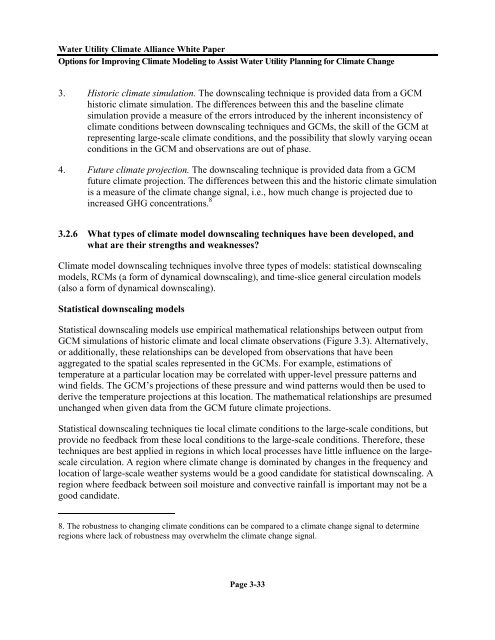Options for Improving Climate Modeling to Assist Water Utility ...
Options for Improving Climate Modeling to Assist Water Utility ...
Options for Improving Climate Modeling to Assist Water Utility ...
You also want an ePaper? Increase the reach of your titles
YUMPU automatically turns print PDFs into web optimized ePapers that Google loves.
<strong>Water</strong> <strong>Utility</strong> <strong>Climate</strong> Alliance White Paper<br />
<strong>Options</strong> <strong>for</strong> <strong>Improving</strong> <strong>Climate</strong> <strong>Modeling</strong> <strong>to</strong> <strong>Assist</strong> <strong>Water</strong> <strong>Utility</strong> Planning <strong>for</strong> <strong>Climate</strong> Change<br />
3. His<strong>to</strong>ric climate simulation. The downscaling technique is provided data from a GCM<br />
his<strong>to</strong>ric climate simulation. The differences between this and the baseline climate<br />
simulation provide a measure of the errors introduced by the inherent inconsistency of<br />
climate conditions between downscaling techniques and GCMs, the skill of the GCM at<br />
representing large-scale climate conditions, and the possibility that slowly varying ocean<br />
conditions in the GCM and observations are out of phase.<br />
4. Future climate projection. The downscaling technique is provided data from a GCM<br />
future climate projection. The differences between this and the his<strong>to</strong>ric climate simulation<br />
is a measure of the climate change signal, i.e., how much change is projected due <strong>to</strong><br />
increased GHG concentrations. 8<br />
3.2.6 What types of climate model downscaling techniques have been developed, and<br />
what are their strengths and weaknesses?<br />
<strong>Climate</strong> model downscaling techniques involve three types of models: statistical downscaling<br />
models, RCMs (a <strong>for</strong>m of dynamical downscaling), and time-slice general circulation models<br />
(also a <strong>for</strong>m of dynamical downscaling).<br />
Statistical downscaling models<br />
Statistical downscaling models use empirical mathematical relationships between output from<br />
GCM simulations of his<strong>to</strong>ric climate and local climate observations (Figure 3.3). Alternatively,<br />
or additionally, these relationships can be developed from observations that have been<br />
aggregated <strong>to</strong> the spatial scales represented in the GCMs. For example, estimations of<br />
temperature at a particular location may be correlated with upper-level pressure patterns and<br />
wind fields. The GCM’s projections of these pressure and wind patterns would then be used <strong>to</strong><br />
derive the temperature projections at this location. The mathematical relationships are presumed<br />
unchanged when given data from the GCM future climate projections.<br />
Statistical downscaling techniques tie local climate conditions <strong>to</strong> the large-scale conditions, but<br />
provide no feedback from these local conditions <strong>to</strong> the large-scale conditions. There<strong>for</strong>e, these<br />
techniques are best applied in regions in which local processes have little influence on the largescale<br />
circulation. A region where climate change is dominated by changes in the frequency and<br />
location of large-scale weather systems would be a good candidate <strong>for</strong> statistical downscaling. A<br />
region where feedback between soil moisture and convective rainfall is important may not be a<br />
good candidate.<br />
8. The robustness <strong>to</strong> changing climate conditions can be compared <strong>to</strong> a climate change signal <strong>to</strong> determine<br />
regions where lack of robustness may overwhelm the climate change signal.<br />
Page 3-33

















